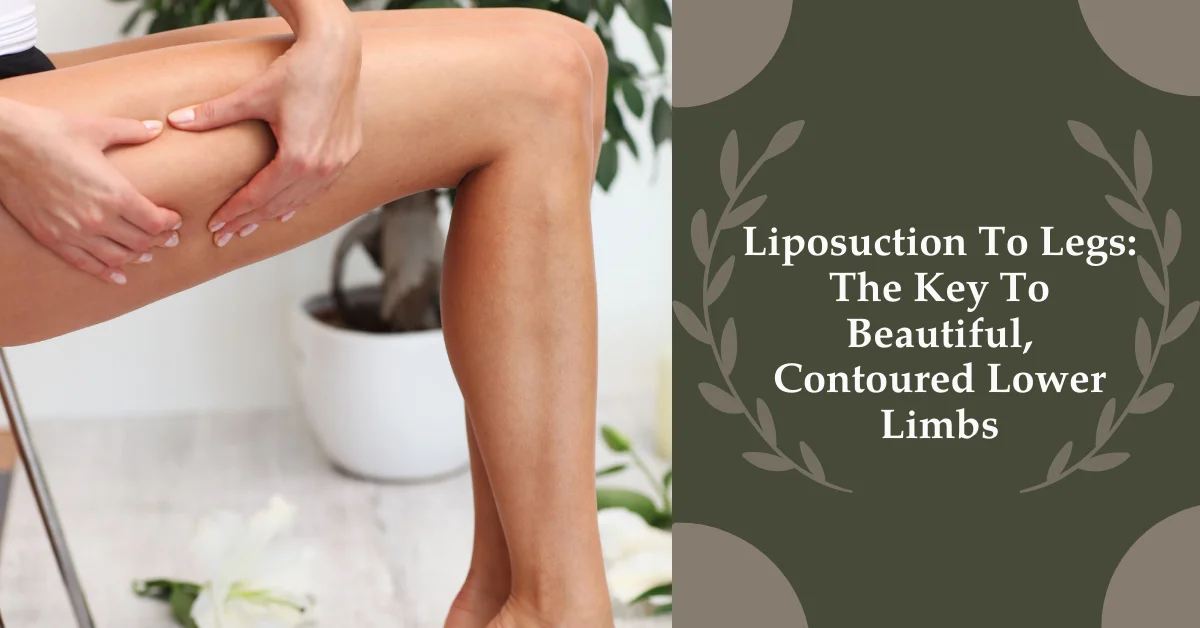We all desire beautifully contoured lower limbs, but sometimes, stubborn fat deposits just won’t budge, no matter how hard we work out or watch our diets. Genetics, age, and lifestyle factors can sometimes stand in the way. Thankfully, there’s a solution that has been helping individuals achieve their leg goals – liposuction to the legs.
In this article, we will explore what liposuction to the legs is, how it works, its benefits, and what to expect during the procedure and recovery. So, if you’re curious about enhancing the appearance of your lower limbs, keep reading to discover the key to beautiful, contoured legs.
What Is Liposuction To Legs?
Liposuction for the legs, alternatively referred to as leg liposuction, is a cosmetic surgical technique meticulously crafted to eliminate excess fat deposits from the thighs, knees, calves, or ankles. The primary objective of this procedure is to enhance the appearance of the lower limbs by sculpting and contouring them to achieve a more toned and aesthetically pleasing look. It’s often chosen by individuals who struggle with stubborn fat in their legs that doesn’t respond well to diet and exercise alone.
The liposuction process involves making small incisions in the targeted areas of the legs and using a thin, hollow tube called a cannula to break down and suction out the excess fat. By selectively removing fat cells, this procedure can help improve the contours of the legs, giving them a more proportional and attractive appearance.
Liposuction to the legs is typically performed under anesthesia, and it offers several benefits, including improved body confidence, precise fat removal, and long-lasting results. However, it’s essential to consult with a board-certified plastic surgeon to decide if you are a suitable candidate for this procedure and to discuss your specific goals and expectations.
How Does Liposuction to Legs Work?
Liposuction to the legs is a cosmetic surgical procedure aimed at eliminating excess fat from the thighs, knees, calves, or ankles to enhance the appearance of the lower limbs. Here’s how the procedure typically works:
- Consultation: You’ll start by consulting with a board-certified plastic surgeon. In this initial consultation, you will have the opportunity to openly discuss your objectives, any apprehensions, and your anticipated outcomes. Subsequently, your surgeon will conduct a comprehensive evaluation of your overall health to determine your eligibility for the procedure.
- Anesthesia: Before the surgery, you’ll be administered either local or general anesthesia, depending on the extent of the liposuction.
- Incisions: Small incisions are made strategically in the target area. These incisions are typically very small, minimizing the risk of noticeable scarring.
- Fat Removal: A thin, hollow tube called a cannula is inserted through the incisions. The surgeon uses this tube to break down and suction out the excess fat from the legs.
- Closing Incisions: After the targeted fat has been successfully removed, the incisions will be meticulously closed using sutures.
- Recovery: Following the procedure, you will be closely monitored in a recovery area until the anesthesia’s effects have subsided. You may experience some localized swelling, bruising, and mild discomfort in the treated areas. Your surgeon will provide you with precise post-operative instructions, which may include wearing compression garments to minimize swelling and support the healing process.
- Results: Full results from liposuction to the legs may take several weeks to become apparent as swelling subsides. It’s important to follow your surgeon’s post-operative care guidelines to ensure the best possible results.
It’s worth noting that liposuction should not be considered a method for weight loss; instead, it serves as a body contouring procedure. It is most effective for individuals who are at or near their target weight but have localized regions of stubborn fat that do not respond effectively to dietary changes and regular exercise.
Benefits of Liposuction to Legs
Now that you have a basic understanding of how leg liposuction works, let’s explore some of its key benefits:
- Improved Contours: Achieve a more aesthetically pleasing silhouette and well-defined, toned legs.
- Targeted Fat Removal: Precisely address problem areas like thighs, knees, calves, or ankles.
- Boost in Confidence: Enhance self-esteem and body confidence by achieving the legs you desire.
- Long-Lasting Results: Typically, fat cells do not regenerate in treated areas for lasting outcomes.
- Minimal Scarring: Incisions are small and discreetly placed to minimize noticeable scarring.
- Customizable: Tailored to your specific needs and desired outcomes for a personalized look.
- Quick Recovery: Shorter downtime compared to more extensive surgical procedures.
- Complementary Procedures: Can be combined with other cosmetic treatments for a comprehensive leg transformation.
What to Expect During and After the Procedure
During and after liposuction to the legs, there are several important aspects to consider:
During the Procedure
During the liposuction procedure, you can expect to be under anesthesia, which can vary from local anesthesia to general anesthesia, depending on the extent of the liposuction and your surgeon’s recommendations. You will not experience pain during the surgical procedure due to the anesthesia.
Your surgeon will make small, strategically placed incisions in the targeted areas of your legs. Through these incisions, a thin, hollow tube called a cannula will be inserted to break down and remove excess fat.
The surgeon will work diligently to sculpt and contour your legs to achieve your desired look. The length of the procedure depends on the specific areas being treated and the amount of fat to be removed.
After the Procedure
Following liposuction to the legs, you will be under close monitoring in a recovery area until the effects of the anesthesia wear off. You can anticipate some swelling, bruising, and mild discomfort in the treated areas, which is normal and should gradually subside over time.
Your surgeon will provide you with comprehensive post-operative instructions, which may include wearing compression garments to minimize swelling and support the healing process. Following these instructions carefully is essential to ensure the best possible results. Full results may take several weeks to become apparent as swelling continues to decrease.
While recovery times can vary from person to person, most individuals can typically return to their normal activities within a few days to a couple of weeks, depending on the extent of the procedure and their individual healing process. Throughout the recovery period, it’s crucial to attend follow-up appointments with your surgeon to monitor your progress and address any concerns.
How Much Does Liposuction For Legs Cost
The cost of liposuction for legs can vary significantly depending on several factors. These factors include the geographic location of the surgical facility, the experience and reputation of the surgeon, the extent of the procedure (i.e., which areas of the legs are being treated), the type of anesthesia used, and additional fees such as facility fees, anesthesia fees, and post-operative care costs.
On average, the cost of liposuction for legs in the United States can range from $2,000 to $5,000 per area (such as thighs, knees, calves, or ankles). Keep in mind that this is a rough estimate, and the actual cost can be higher or lower depending on the factors mentioned above.
It’s essential to consult with a board-certified plastic surgeon for a personalized consultation to get an accurate cost estimate tailored to your specific needs and goals. During the consultation, the surgeon can evaluate your case, discuss the areas you want to target, and provide you with a more precise quote.
Additionally, make sure to inquire about any potential financing options or payment plans that may be available to help manage the cost of the procedure. Remember that the quality of the surgeon and the safety of the procedure should be the top priorities when considering liposuction, so choose your surgeon wisely.
Is Liposuction to Legs Right for You?
Determining whether liposuction to the legs is the right choice for you involves several factors. Firstly, you should be in good overall health and at a stable weight, as liposuction is not a weight loss solution but a contouring procedure. It’s essential to have specific areas of concern on your legs, such as the thighs, knees, calves, or ankles, that you’d like to address.
Realistic expectations are vital, as liposuction can significantly improve contours but may not result in a complete transformation. Additionally, you must commit to post-operative care and follow your surgeon’s instructions for the best results.
Ultimately, consulting with a board-certified plastic surgeon is the key step to determining your candidacy, as they can assess your individual case and discuss your goals to help you make an informed decision about whether liposuction to the legs aligns with your objectives and expectations.
Conclusion
In the quest for sculpted legs, liposuction emerges as a compelling option. It offers the promise of enhanced contours, targeted fat removal, a boost in confidence, and long-lasting results. However, it’s not a one-size-fits-all solution, and the decision to undergo liposuction to the legs should be made after careful consideration and consultation with a skilled surgeon.
By setting realistic expectations, committing to post-operative care and aftercare tips, and aligning your goals with the possibilities of the procedure, you can unlock the potential for beautiful, contoured lower limbs and stride confidently toward a more confident you.









